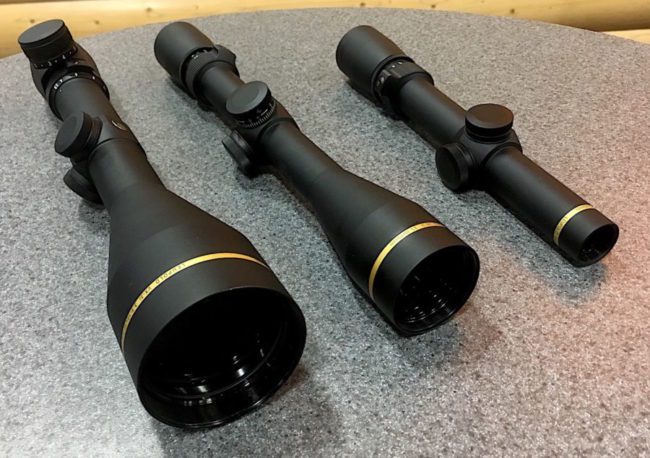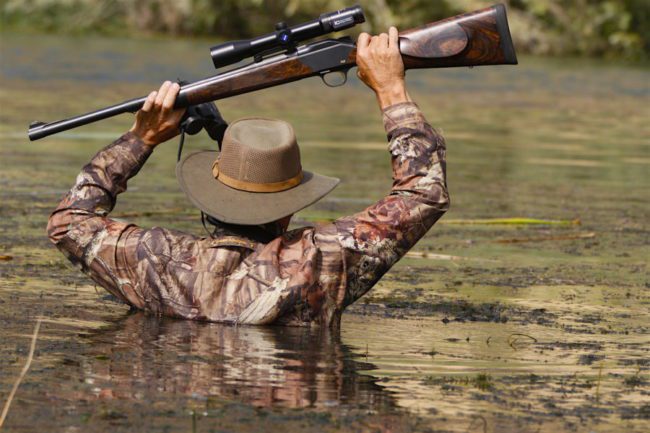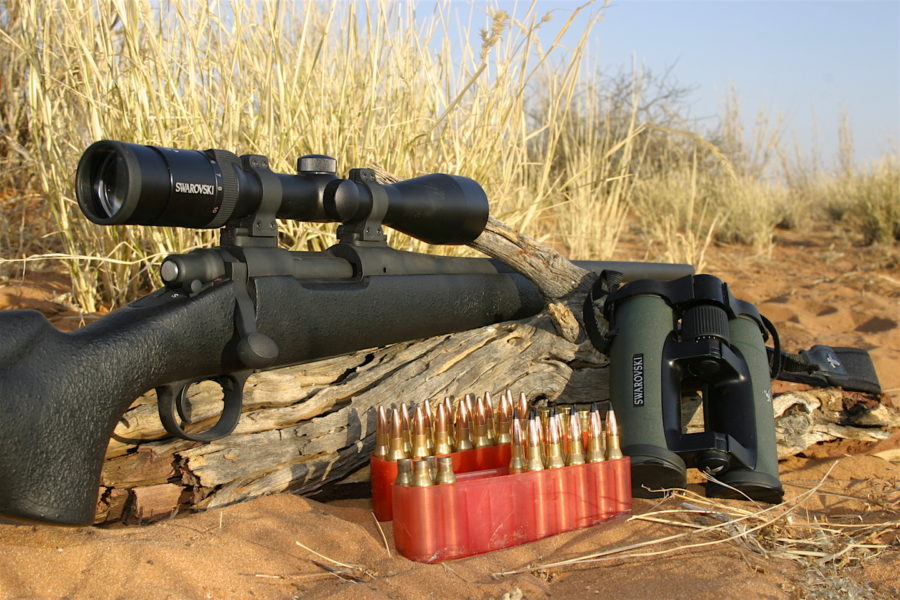Tough. Durable. Consistent. That’s what you want in an Africa hunting scope.
Despite our best technology—HD glass, illuminated reticles, ballistic reticles, dial turrets, parallax adjustment dials, and 8X zoom ranges—a riflescope is really just a front sight. Yes, it is magnified and glorified, but still, its main job remains pretty basic—keep pointing where the barrel delivers bullets. The brightest, most powerful scope in the world is useless if it can’t hold zero. So put durability first on your list of qualifications for an Africa hunting scope.
BACKING UP DURABILITY IN AN AFRICA HUNTING SCOPE
Of course, durability is a relative term when you’re dealing with a complicated, mechanical instrument filled with glass. No matter how tough they’re built, scopes remain the weakest link on most rifles. If anything is going to break or malfunction during your Africa safari, chances are it’ll be your scope.
For this reason I always carry a backup scope to Africa, one already mounted in Leupold or Talley quick-detach rings and zeroed to my rifle and load. This backup scope doesn’t have to be a fancy model, but a rugged one. The engineers at Leupold tell me their least expensive scopes are as rugged and durable as their most expensive—and hold zero just as reliably. That’s the kind of assurance I like in a backup scope.
Over the years I’ve inadvertently tested this to my satisfaction, having dinged, banged, and dropped Leupold scopes from Arctic mountains to African deserts. None has ever failed. I’ve bashed a few hard enough to knock them off sight, even to put dents in them, but after re-zeroing, they went right back to work.
I’m sure some other brands are this rugged; I just haven’t had as much experience with them. If you have, stick with the scope or brand you believe in. Durability is tough to shop for. How do you recognize it? Manufacturer guarantees and warranties are a good hint. Lifetime guarantees—the kind that say a company will repair or replace a scope for any reason—suggest the maker doesn’t think too many of its scopes are going to break. This doesn’t prove they are the most durable, but strongly hints at it.
To test a new scope for basic, functional durability, fire at least 20 rounds with it mounted on your rifle. Forty would be better. That’s usually enough to shake loose anything that wasn’t tied down properly. If the instrument runs fine for 40 rounds, it’s probably good for 4,000.

The three bears. For most Africa plains-game hunting, you don’t need too small or too big, but just right, like the Leupold VX3i 3.5-10×40mm in the center.
HOW MUCH MAGNIFICATION DOES AN AFRICA HUNTING SCOPE NEED?
Don’t fall for the antiquated advice about low scope power for Africa. A 1-4X or 1.5-6X is fine for dangerous game or larger plains game in tight cover, but for virtually all of the safari hunting I’ve done, a 3-9X or 4-12X was more effective. In the southern Africa hunting countries we’re focusing on in this Plains Game Safari series of articles, you’ll find a mix of dense brush and open grasslands or desert. You’ll encounter most game at 100 to 500 yards, and most shots should fall between 100 and 300 yards. A scope at 4X has more than enough field of view to clearly target a 1,500-pound eland at 30 yards, but might not have the reach you’ll want on an 80-pound springbuck at 350 yards. Even when I hunted buffalo in the dense swamps of Mozambique, my Zeiss 2.5-10X Victory wasn’t too much scope.
WHAT YOU DO NOT NEED IN YOUR AFRICA HUNTING SCOPE?
What you don’t need is an oversized main tube or a huge objective lens. Those 30mm, 34mm main tubes and 50mm, 56mm objectives? Unnecessary. There’s nothing wrong with them if you want to carry them, but they give you no significant, useable advantages over smaller versions.
Here’s why: High-quality, fully multi-coated scopes transmit 90 percent or more of the light that enters them these days, and at 8X even a 40mm objective produces a 5mm Exit Pupil, more than enough to clearly see a black reticle against the dark hide of a wildebeest a good half-hour after sunset, if not later. Most African PHs wrap up the day’s hunt shortly after sunset anyway. There’s so much game that you rarely have to sit around hoping something will stick its head out at last light like a wary old whitetail.
Big tubes and objectives are really only important if you’re setting up an extreme-range rifle for shots 500 yards and beyond. Turret dialing can be extended via the extra room in a big main tube, and Exit Pupil diameter can be kept larger at high magnification settings.

Southern Africa is usually bright, warm, dry, dusty, sandy, rocky, thorny, and hard on scopes. You need durability and dependability in your scope. That’s a 40-inch bull oryx, by the way, taken from about 320 yards with a handloaded Barnes TSX fired from an Empire Mauser in .300 Win. Mag. directed by a Leupold VX3 3.5-10x40mm scope.
BALLISTIC RETICLES OR TURRETS?
Choose turret dialing or ballistic reticles if you like, but I’d shy from both in an African hunting scope. Unless you are extremely fast and competent operating an elaborate scope, you’ll be better off with a simple duplex reticle and a Point-Blank-Range sighting system. This will suffice for well over 90 percent of your shots.
If you do want/need to shoot long range using a laser rangefinder and BDC reticle or turret dialing, make darn sure you buy it and train with it long before your trip. And train until you can run it half asleep. Arriving in Africa with new, complicated scopes and magnum rifles is probably the most common mistake first-time safari hunters make. The animals love it, but all those misses will drive you and your PH nuts. Some southern African hunting grounds are particularly open. Check with your PH and ask what he recommends. If he suggests you may have to take many 300- to 500-yard shots, you’ll want a scope system that can handle that. Just don’t get so preoccupied with complicated sighting systems that you end up fiddling indecisively when you should be concentrating on your shot.
LENS COATINGS HELP MAKE THE PERFECT AFRICA HUNTING SCOPE
As with any optical tool, get the best anti-reflection coatings you can afford. The more the better, because these coatings maximize light transmission and minimize glare and flare. When your shot is looking toward the setting sun, you’ll appreciate excellent coatings. They are the biggest bang for your buck in optical performance.
Lens surface coatings designed to shed fog and fingerprints or resist scratching, like Leupold’s Diamondcoat and Swarovski’s Swaroclean, aren’t absolutely necessary, but they offer good protection against the dust on southern Africa hunts.
HD LENSES
HD and ED lenses are more hyped than understood. They are a certain type of fluoride glass that minimizes something called “color fringing.” Basically, this makes objects look sharper, crisper, better defined. Fluoride lenses don’t contribute much at less than 10X magnification, but at 15X and above they really begin to make a difference. However, since a riflescope is an aiming device, not a game location and identification instrument, I don’t feel HD/ED lenses are of major benefit. If cost is no object, I’d sure get them. Otherwise I’d save my money for HD glass in my binocular and spotting scope.
ILLUMINATED RETICLES
This is a personal choice. I’ve never found them necessary for putting my aiming point on target, but my wife does. A little red center dot helps her focus on the precise aiming spot. She’s not alone. Many shooters find illuminated reticles enhance concentration and build confidence. When that tiny red dot hovers over the sticking place, you know you’re on.

The one thing you probably don’t need in a southern Africa hunting scope is waterproof construction—unless you’re going after crocodiles and hippo. The unusual-looking rifle is Blaser’s R8, a modular bolt action with quick-swap barrels. I went with 7mm Rem. Mag. and .458 Lott on this trip.
EYE RELIEF
Often overlooked, eye relief (ER) can make the difference between a pleasant shot and a sharp cut above the eyebrow. ER is the distance from the ocular (eyepiece) lens to your eye when you have a full, complete view without edge blackout. ER is set for each scope at the factory and cannot be changed by the user except slightly by turning the diopter adjustment ring. This moves the ocular lens in and out to accommodate different users’ eye strengths.
Most scopes come with anywhere from three to four and a half inches of ER. On a hard-kicking rifle, or for shooters who creep forward on the stock (commonly done when excited or shooting steeply uphill), a minimum of three and half inches of ER is smart, and four is smarter. On any scope, note how far the ocular bell or housing protrudes past the actual glass lens. Then consider how far your brow protrudes beyond your eyeball. Added together, these two protrusions could knock off a half-inch of functional ER. After all, it is your brow and that metal eye ring that are going to connect.
CLEANING KIT
A lens brush and microfiber cloth in a plastic baggie will suffice if you use them. African dust quickly layers on lenses, and that acts to dim the view and increase flare. A quick brushing at midday and each evening should optimize your sighting picture. Avoid wiping unless oil and gunk befoul the lenses. Liquify the gunk and wipe gently many times instead of pressing and grinding hard one or two times. You’re trying to lift debris off the lens, not grind dust and sand into the lens.
For more from Ron Spomer, check out his website, ronspomeroutdoors.com, and be sure to subscribe to Sporting Classics for his rifles column and features.

